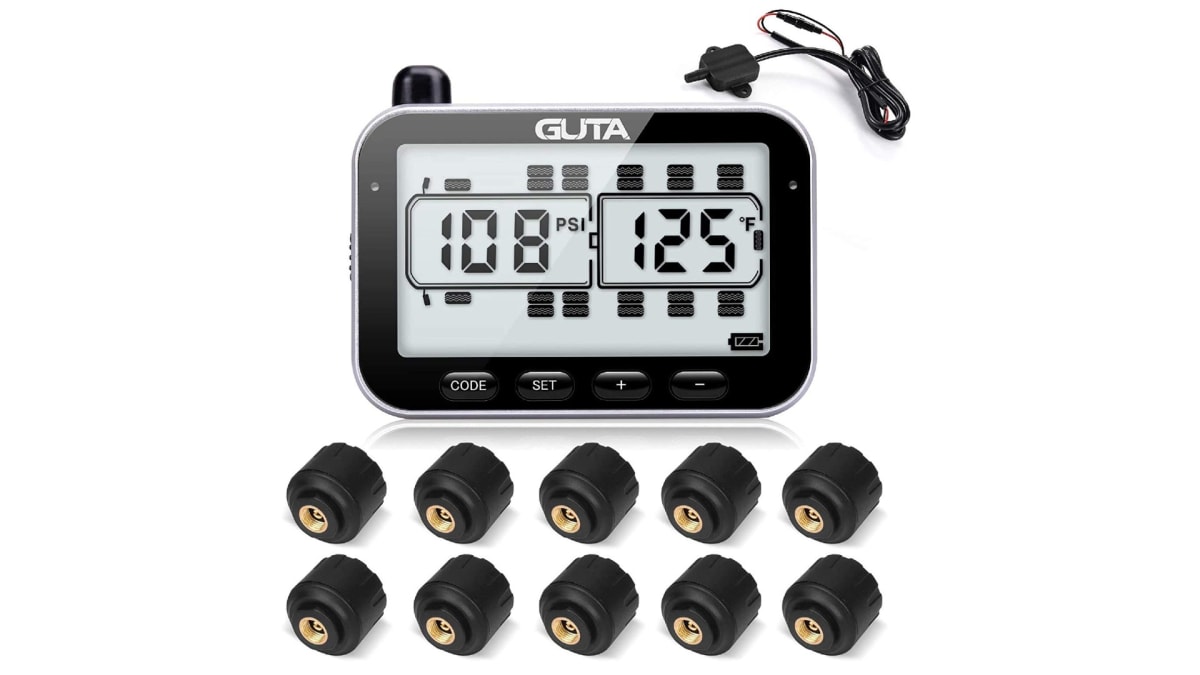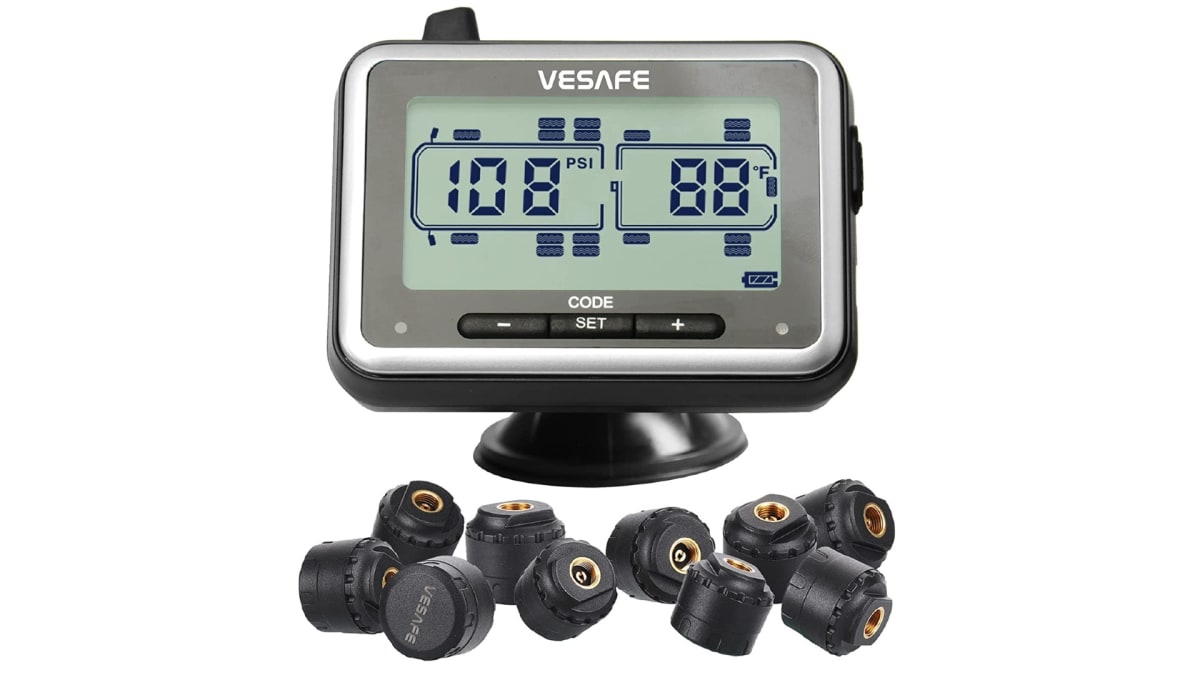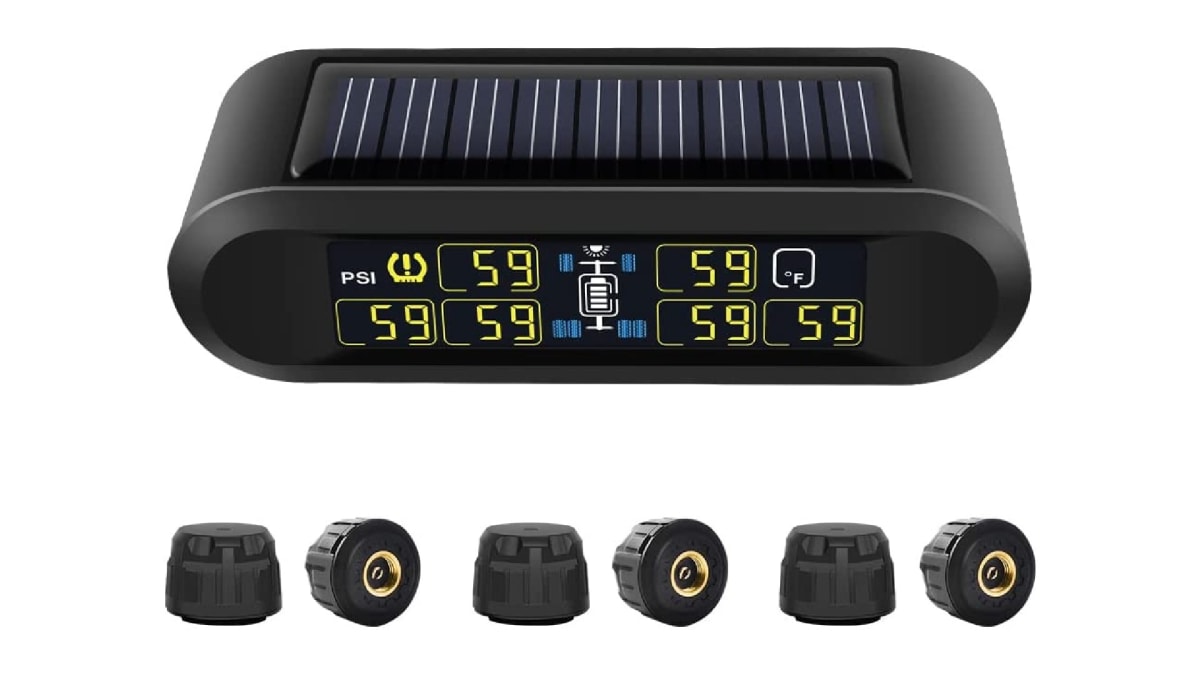Keep your tires optimized with the best tire pressure monitoring systems

Autoblog is not affiliated with the brands featured in our articles, but when you make a purchase through links on our site we may earn a commission.
Flat tires ruin road trips and create unsafe driving conditions. Buy a premium tire pressure monitoring system in 2022 to prevent mishaps while driving. Imagine getting ready for a fun road trip with your friends, loading up your car with snacks and gear, only to be halted by a flat tire in the middle of nowhere. Bummer, right? Installing a tire pressure monitoring system (TPMS) in your vehicle can save you from disappointing moments like this, as this system is designed to provide timely warnings about under-inflated tires.
An unexpected flat tire is not only frustrating but also unsafe, and can lead to accidents. Installing a tire monitoring system in your car can help you keep your tires at optimal pressure, but choosing the right one can be overwhelming due to the variety of systems available. In this article, you’ll learn about some factors to consider when buying a tire pressure monitoring system, and you can also find a solid solution for your car with our detailed reviews of the leading tire pressure monitoring systems of 2022.
What are the leading tire pressure monitoring systems of 2022?
Tymate Tire Pressure Monitoring System: Great pick
Buy on Amazon
The Tymate tire pressure monitoring system is a versatile device that supports solar-powered charging and also comes with a USB charging cable so you can still charge it when it’s cloudy out. This setup features five different alarm modes, including a high/low-pressure alarm, a high-temperature alarm, a fast leak alarm, and a low voltage sensor alarm. Users can set the temperature and pressure alarm values on this system for more customized usage, with the system’s available pressures ranging from 12 to 87 psi. This tire pressure monitoring system automatically adjusts the backlight display depending on the amount of light you’re working with, and its display also changes colors in different conditions. Thanks to its versatility and abundance of features, this tire pressure monitoring system is high on our list.
Pros
Five alarm modes for different functions
Solar and plug-in power compatible
Automatic sleep mode after 10 minutes
Self-adjusting display brightness for better readability
Cons
Can be challenging to install
GUTA Tire Pressure Monitoring System: Recommended

Buy on Amazon
The GUTA tire pressure monitoring system has a built-in rechargeable battery that can quickly be charged in just four hours with the included USB charging cable. With a long-lasting battery life of up to 14 days, this tire pressure system is great for long-distance travel, and its energy-saving large LCD screen will also conserve battery while monitoring up to 24 tires. You can check the temperature and pressure of your tires at the same time on the screen of this tire pressure monitoring system, and it can even transmit sensor signals up to 80 feet. With its easy-to-install and straightforward setup, anyone can install it in their vehicle to help them keep track of their tires’ pressure.
Pros
Seven alarm modes for better functionality
Short charge time, extended battery life
Dustproof, waterproof, anti-corrosion, and -theft design
Large, auto-dimming screen
Cons
Four-sensor model doesn’t include a repeater
Vesafe Tire Pressure Monitoring System: Another great option

Buy on Amazon
The Vesafe tire pressure monitoring system is a safety tool made for all kinds of recreational vehicles, including trailers, motor homes, and of course your trusty everyday RVs. This system will let you know when your vehicle’s tires are approaching unsafe conditions, including over-inflation, under-inflation, overheating, and fast leakage. This tire pressure monitoring system features an LED signal that will light up and keep flashing if tire pressure is 10% higher or 20% lower than your preset standard pressure until the tire(s) in question are restored to sufficient pressure. This tire pressure monitoring system has a battery life of two years, and when the low-battery icon pops up on the system’s screen all you’ll have to do is simply pop the low battery out and replace it with a new one to continue using it.
Pros
Five different hazard alarm modes
Comes with ten lithium metal batteries
The large screen displays up to 17 tires
Shows real-time temperature and pressure
Cons
Mediocre windshield and dash mount
TireMinder Tire Pressure Monitoring System: High quality

Buy on Amazon
The TireMinder tire monitoring system can swap between the front and rear parts of a vehicle, letting you monitor up to 20 tires without having to press any buttons yourself. The system’s bright, always-on display monitor shows precise real-time vehicle details, and this will be the case no matter whether you’re stationary or cruising down the highway. This tire pressure monitoring system has a powerful Rhino signal booster that can offer up to three times more range than you’d get with other systems. The system establishes a stable connection that’s up to 100 feet for a vehicle in motion and 200 feet for stationary vehicles, so you should be good to check your tire pressure no matter what you’re up to on the road.
Pros
Provides visual and audio issue alerts
Can be used stationary and in motion
Eight lithium metal batteries included
Lifetime customer support is available
Cons
Improper installation can lead to poor results
B-Qtech Tire Pressure Monitoring System: Budget option

Buy on Amazon
The B-Qtech tire pressure monitoring system is a wireless system that supports both solar and USB charging. You can quickly charge its rechargeable lithium battery without using your car’s cigarette lighter socket, and it’s great for use with four to six different tires. This tire pressure monitoring system accurately displays real-time tire pressure and temperature levels, and you can check these out on its easy-to-read, high-resolution LCD screen. If there’s something wrong with your vehicle’s tires, this system will play one of five different alarm sounds, so you won’t have to look at the screen while driving to know something’s up.
Pros
Five unique alarm sensor modes
Automatic alerts when issues arise
Provides a stable and accurate signal transmission
Lightweight, easy-to-install design
Cons
The battery is a bit small
Buying guide: Tire pressure monitoring systems
Keeping your vehicle in top shape is essential for a smooth ride. There are various tire pressure monitoring systems available on the market with different features and specifications, and if you don’t want to be confused when trying to buy one of the top choices in 2022 then check out our buying guide that can help you make a well-informed decision.
Factors to consider when looking for a tire pressure monitoring system
These factors should act as your guiding star when looking for a high-quality tire pressure monitoring system:
Sensors
The main thing to look for in a tire pressure monitoring system is its sensors. A monitoring system’s quality typically depends on the universality of its sensors. You should pick a device that accepts universal sensors, and this is important because not every sensor is universal. If you don’t, and your car’s sensors fail, they’ll cause the entire system to fail.
Programmable modes
Another important feature of such systems is the number of programmable modes they have. Many tire monitoring systems come with two or three programmable modes that you can set up, and these modes help monitor the car’s PSI tire pressure better. You can also use these modes for re-tuning your car’s old sensor systems to make them compatible with your newly installed monitoring system.
Accuracy
It might sound obvious, but it’s better to get a highly accurate tire monitoring system for your car. How easy it is to reprogram new sensors in your car determines how high the accuracy of the sensors is. You can also use the tire’s temperature to determine sensor accuracy and to be extra sure you can even head down to the gas station and compare it with the readings on the equipment there.
Ease of installation
No one likes reading long manuals and dealing with complicated installation processes, and a tire pressure monitoring system should not be hard to set up. Depending on the type of system, you should be able to clamp it on or screw it into your car’s tires. A solid monitoring system is one that you can install by yourself without needing a technician’s help.
Display system and readability
Tire pressure monitoring systems are composed of both an indoor and an outdoor unit. You clamp the outdoor unit on the tires or place it inside them and then use the indoor unit to view important information about the tires on its display screen. Make sure you purchase a device with precise detailing, readable font, sufficient brightness, and ideal color combinations for ideal readability.
Power and battery life
Your car’s TPMS can utilize different power sources, and you should choose the one that fits your needs. If you regularly maintain your vehicle, you should invest in a battery-powered system — these systems usually come with a 12-volt power socket or a USB charging cable. You can also choose a solar-powered device, and these are pretty easy to install.
Types of tire pressure monitoring systems
Tire pressure monitoring systems come in two types:
Indirect tire pressure monitoring system
The indirect TPMS relies on wheel speed sensors used by the anti-lock brake system to determine tire pressure, measuring each wheel’s revolution rate. The onboard computers use this information to compare the performance of all tires along with other crucial data, like speed.
If a wheel spins faster than its average speed, the computer will detect that it’s underinflated and warn the driver. Because of this, an indirect system doesn’t measure the actual tire pressure — instead, it gives an indirect measurement.
These systems are relatively cheaper than direct systems and require less programming and maintenance, but the accuracy of their measurements is not guaranteed.
Direct tire pressure monitoring system
The direct TPMS does not use wheel revolution rate to measure tire pressure — it uses specialized pressure monitoring sensors found in each tire. Instead of indirect assessments, these sensors help measure specific pressure levels and deliver accurate tire pressure readings.
Such systems are usually expensive and may require specialized tools for resynchronization. Their batteries typically last for more than a decade, but you’ll need to replace the entire sensor once they drain.
Benefits of tire pressure monitoring systems
Installing a tire pressure monitoring system offers vehicle owners many benefits, such as:
A TPMS allows you to monitor your tires’ air pressure on the go. If you install this system, you won’t need any pressure or reference gauge to measure your tires’ air pressure. You don’t even need to stop your car, as the display will show all the required information as you drive
You don’t need to check up on the gauge with a pressure monitoring system constantly. These systems come with one-gauge-fits-all models that will stay inside the tires
When everything is pre-installed and functional, you save a lot of time. With a TPMS you won’t need tools to check tire pressure, and you can see the readings on the system’s monitor whenever you want
You don’t have to carry specialized tools or acquire technical skills to measure tire pressure
Why you should consider a tire pressure monitoring system
There are various reasons for installing a tire pressure monitoring system in your vehicle. We’ve mentioned some of these below:
Reduce safety hazards
An under-inflated tire can prove to be a safety hazard, leading to car accidents and tire blowouts. Installing a TPMS in your car and keeping an eye on your tires’ air pressure can help to avoid this.
Improve fuel economy
Driving with under-inflated tires causes them to wear out quicker and reduces your vehicle’s fuel economy. You can save money on your fuel consumption and cut maintenance costs by monitoring your tires’ air pressure using a TPMS.
Increase vehicle value
If you ever sell your car, you can benefit from having a tire pressure monitoring system installed. Having such safety features in a vehicle can significantly improve its market value.
Tire Pressure Monitoring System FAQs
Q: When do I need to replace the battery of my tire pressure monitoring system?
Many tire pressure monitoring systems use batteries that may last for five to twelve years. If your monitor stops receiving signals from the sensor, it means it needs a battery replacement. Some sensors let you change the battery and come with tools and instructions, but a lot of sensors need to be replaced once their battery dies.
Q: Can I add a tire pressure monitoring system to my car?
You can usually install a cap-based tire pressure monitoring system on any car without specialized tools. Anyone who knows how to fill tires with air using a gas station air pump has the know-how to install tire sensors.
Q: How accurate are tire pressure monitoring systems?
Most tire pressure monitoring systems are accurate to within one pound per square inch (PSI). The precision of these systems may vary depending on the make and model of your car.




